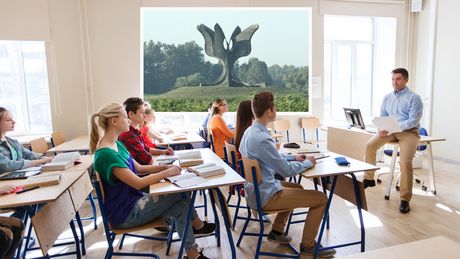Students to learn about NDH genocide against Serbs: This is the first accredited program for history teachers

Minister of Education Branko Ruzic signed the decision by which the educational program of the Museum of Genocide Victims entitled "Learning about the genocide committed against the Serbs" acquired the highest possible status, that of a program in the public interest.
This is the first accredited educational program of the Museum of Genocide Victims since its foundation in 1992, the Museum announced.
The first accredited educational program of the Museum of Genocide Victims entitled "Learning about the genocide committed against the Serbs" will be implemented already in May of this year.
Experts from the Museum of Genocide Victims, the Institute for the Advancement of Education, as well as the Ministry of Education worked for many months on producing this document. Therefore, the Museum used this opportunity to once again express its gratitude and respect to all those who contributed to this achievement.
The Museum expressed its special gratitude to Deputy Prime Minister and Minister of Educatio Branko Ruzic for his continuous support to the activities of this cultural institution of top national importance. The museum also provided more detailed information regarding this accredited educational program.
The genocide committed against the Serbs by the Croatian state (NDH) throughout its territory during the Second World War is an extremely complex and delicate topic for teaching elementary and high school students.
History teachers often hesitate to discuss this topic in more detail with students in class because they are not sure that they are sufficiently familiar with it, that is, that they are trained to teach it in the right way, according to the Museum.
History teachers mostly acquired their knowledge of this topic during initial university education and are often not familiar with the latest results of historical research. In addition, it is a topic about which unverified information is occasionally circulating in the public, which causes confusion among the teachers themselves.
Teaching about the genocide against the Serbs in the NDH, as well as about other forms of suffering of the Serb people during wars, is often focused on presenting historical data, while it is insufficiently focused on improving students' critical thinking and developing their empathy towards the victims.
The Museum of Genocide Victims had the opportunity to learn about the need to improve the competence of history teachers for teaching on these topics through its long-term cooperation with primary and secondary schools in the territory of the Republic of Serbia.
Objectives of the program
The proposed program belongs to the field of social sciences, i.e. history. It aims to develop the competences of teachers of history and other subjects in a narrower professional field, as well as for teaching and learning.
The priority area of professional training to which the program refers is the improvement of professional-methodical, pedagogical and psychological knowledge of teachers of history and other subjects.
The primary target group of the program consists of history teachers in elementary schools, high schools, secondary vocational schools and secondary art schools.
The general goal of the program is to improve the competence of history teachers in primary and secondary schools for the planning and implementation of teaching units that deal with the topic of the genocide committed against Serbs in the territory of the Independent State of Croatia (NDH) during the Second World War, and in connection with this, improving the quality of teaching.
Specific objectives of the program:
- Introducing teachers to the legal and theoretical understanding of the concept of genocide and examples of genocidal crimes throughout history;
- Improving the knowledge of teachers about the genocide committed against Serbs by the Croatian state in the system of concentration and death camps of the NDH in Jasenovac, as well as in numerous other death camps in the territory of the Independent State of Croatia during the Second World War, in the light of current historical research;
- Improving the competences of teachers for the application of innovative and age-appropriate methods and techniques in teaching, i.e. the execution of teaching units in which the genocide against the Serbs in the NDH is dealt with, with the aim, among other things, of improving the students' critical thinking and developing a sense of empathy towards the victims;
- Improving the competence of teachers to recognize cross-subject correlations, horizontal connection of teaching content from different subjects that touch on the genocide against the Serbs in the NDH and related to this, the preparation and execution of teaching projects.
Expected outcomes of the program and practical effects of its implementation
- Attending this training will enable teachers to improve their competences for planning and implementing the teaching unit, teaching in connection with the genocide committed against the Serbs in the territory of the Independent State of Croatia during the Second World War.
- Teachers will be empowered to process this teaching content within regular lessons or within project teaching based on cross-subject connection of related teaching content, independently or in cooperation with teachers of other subjects.
- The training will also lead to the further development of the partnership between school institutions in the Republic of Serbia and the Museum of Genocide Victims, which will be available to the participants after the training for all additional questions and support in the implementation of the lessons, and will also enable them to use the materials created as part of its work for teaching.
- As a result of the training, teachers will improve their knowledge about the genocide committed against Serbs in the NDH in light of current historical knowledge, as well as their teaching skills on this topic.
- Teachers will better understand the identity and social relevance of this topic, as well as the importance of conveying knowledge about it to students in a dedicated and thorough manner.
- Teachers will be trained to use innovative age-appropriate teaching methods, such as short stories, audio-visual materials, and exhibitions, in addition to historical sources, in the implementation of teaching units related to this topic.
- As a result of the application of these methods in practice, students will be encouraged to learn about this topic by simultaneously improving critical thinking and developing empathy for the victims that goes beyond mere memorization of historical data.
(Telegraf.rs)
Video: Tišma: Da je međunarodna zajednica osudila ustaški genocid u Drugom svetskom ratu, Oluje ne bi bilo
Telegraf.rs zadržava sva prava nad sadržajem. Za preuzimanje sadržaja pogledajte uputstva na stranici Uslovi korišćenja.

